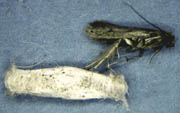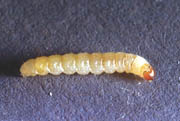Bio Hazards:
(Keeping the little creepy-crawly-hungry things out of your valuable collection.)
Of course it depends on what you collect. If rocks and minerals are your thing, you can stop reading now. (In fact, you can also skip my article on UV / Radiation damage too, 'cause it turns out that rocks don't care about ionizing radiation.) But what if you collect first edition comic books, or antique doll clothes, or sugar packets? You had best be giving some thought to repellent little crawly things as well as things that don't so much crawl as sort of land on your stuff and reproduce like mad -eating all the while.
I must stress, that my advice is rather generic and pragmatic. The chances are that a little research into your specific collectable will provide you with more and perhaps more specifically useful information then you will find here. Also, you might do well to research your specific local for the threats that come with the territory.
Mildew:
To being with the smallest of threats, (this is to say it's a significant threat, but you'd need a microscope to see it), -let's consider mildew. Mildew is a plant -a fungus actually -like mushrooms. It’s like the yeast that makes bread raise and makes less interesting stuff into beer and wine. Not to put too fine a point on it, it’s also the stuff that grown between you toes if you hang out at disreputable swimming pools. (BTW -Did'ja know that what we think of mushrooms are actually only the sexual part of mass of cell that live in the dirt and may be a ball as much as 10 feet in diameter?)
To understand mildew, you need to know that it needs moisture -just like plants and other living things. So the obvious way to protect your collectibles from mildew damage is to keep them dry. When you are done with this article -read up on DESICCANTS -things that suck moisture out of the air. This is perhaps obvious, but what is not so obvious is that dirt also helps mildew get a foothold.* If you collect -let us say- doll clothes, you ought to clean them. If you collect them brand-new -this might not be a problem, but then again.... Turns out that the really elaborate doll clothes are often treated with starch &/or other chemicals that not only nourish mildew -but appeal to some of the larger things like silverfish. So this is why I say keep 'em dry and -if possible- keep 'em clean.
And don't make the mistake of thinking that if your collection is not made out of cloth, you are safe! Paper, leather & fur, dried flowers, plants & seeds, stuffed animals, (deer heads & such -not just teddy bears), wood, wicker, photographs, painted surfaces, and a million other things will all support mildew. Think of it this way -if nature made it, or it’s made out of something that nature made -nature also made something that eats it! This is a good thing. Some scientist once figured out that is it weren't for the ubiquitous little beetle that eats hair -the planet would be about 3 feet deep in hair now. If you have aver shared a home with a good sized dog that sheds -this is not a hard thing to imagine. We will come to the hair-eating bugs shortly.
Silverfish & Firebrats:
These repellent little insect have been around for 300 million years -cockroaches, for example -only 50 million. (People -in their current style and model -considerably less then a million.) The very shape of their bodies has a primitive look about them. Firebrats like it hotter then silverfish, and are darker in color, but you deal with both the same way. They are a little like mildew in that they need water -but unlike mildew -they can go over there to get water and then wonder back over here to eat your stuff, so the problem is a little more complicated. They also have a slightly more selective diet then mildew -they like starch and starch is what things are glued together with -things like books and wallpaper. Here again -the list of things with starch in them goes on and on. Older things were much more likely to be glued together with starch glue or paste then modern things that are glued with modern -unappetizing- glues.
As to dealing with these bugs, you need to take a more holistic approach because of their ability to wonder around to get a drink and what-not. There are a variety of commercial bug sprays that can deal with an infestation well enough and it is likely that a given geographic area will have it's favorite poison. There are a couple of 'folk-remedies' that might be worth trying and that don't involve harmful poisons. One is to mix borax and flour and leave it out. The bugs sort of over-doses on the flour and the borax bubbles up and the little f___ers pop!??! I can't say if this approach works or not -but it's fun to imagine repellent little insects moaning "I can't believe I ate that whole thing" and then exploding. Supposed to work on cockroaches too. Kind of like leaving a dish of beer out in the garden to attract snails. Then you are to dispose of drunk snails?
How To Get Rid of Stuff.com sez "Infested books can be sealed in a plastic bag along with some desiccant and placed inside of the freezer for three days to kill any resident silverfish and firebrats. If your book case has become infested, consider spreading some diatomaceous earth behind the books on the shelves to keep the moisture levels down and kill any paper-eating insects that may be hiding out." Here we see moisture as an issue once again. And here is the link -once again- to DESICCANTS
Moths and Hair-eating Beetles:
Turns out that it’s not the moth that actually eats wool. It’s the larval stage –ugly little bugs. But the moths lay eggs so you need to be aware of both. And it also turns out that they eat wool, fur (and what is wool but sheep-fur after all?) and feathers. But they don’t care for cotton, silk or any synthetic fibers. Silk I understand I suppose –silk has already gone through a bug and emerged as it’s cocoon, but they don’t care for cotton? –but they eat feathers? Feathers? Not for me to say I guess.
 Casemaking clothes-moth and cocoon
Casemaking clothes-moth and cocoon
 Casemaking clothes-moth larva. (This is the villain!)
Casemaking clothes-moth larva. (This is the villain!)
So how to keep them out of your collection? By now you may have guessed that keeping things dry is a good first step. I have no idea what the little bugs find to drink while eating your woolen stuff, but they don’t do well at all with the relative humidity less then 30%. They also need certain minerals to survive. Human sweat is a wonderful source of these minerals so –SURPRISE!- put things away CLEAN. (And remember that dirt and salt are also hydro-scopic. This means that they absorb water from the air so you will not only be giving the repellent bugs a vitamin boost, but a nice drink of water if you put your collectibles away dirty.
What about mothballs and the like? These chemicals –and there are two main ones –moth flakes and moth-balls –each a different chemical –are ordinarily repellents but can act as poison if the concentrations are high enough. Once they have evaporated, the game starts a-new. Unless you have your collection sealed up very well indeed, you may find that you have a moth problem all over again –despite the fact that you used moth stuff and kept things closed up. One species of wool eater can crawl through a hole less then 1 mm wide. You must also read the instructions on the box this stuff comes in. They can dissolve certain plastics –like the plastic used to make big boxes to store winter clothes ?!?! In humid conditions, they can also stains fabrics, so put them / it in a paper folder or envelope. Once the balls or flakes evaporate, the gas can go through almost anything.
Like the silverfish above, you can freeze hair-eaters in any stage of their development. Let them become acclimatized to a nice warm place in your house, them pop them in the freezer (set at the coldest setting) for 72 hours and the problem is solved. Till another moth flits by and lays her eggs anyway.
Timothy Porter has this to add: "Another product that is a very inexpensive and effective desiccant is diatomaceous earth. This is the same filter powder used in in-ground swimming pools. Made of diatoms, microscopic fossils of ancient sea life, it not only is a great moisture absorbent, but also, because it does not biodegrade any further than its present state, it irritates and damages the chitinous exoskeletons of all manner of insects, rendering them unable to maintain the necessary internal moisture to survive. DE is commonly used in orchards, spread on the ground, to kill off the nymph stages of most herbivorous insects and to dry out slugs and snails.
The Colorado State University has a great article on this subject. It’s kind’a pointed at Colorado and other dry climates, but check out…
Clothes Moths: Identification and Control in the Home
*I once had a sailboat that spent the winter on the water and was closed up and damp. There was a nice clean towel that got left behind and got wet -but didn't have a spec of mildew on it. There was also a vinyl notebook holding instructions and warranties etc. This grew mildew. Not the paper -but the vinyl! Plastic is not supposed to be nutritious to anything I thought, but you could see my hand-prints growing mildew very clearly. Evidently I had been doing something with dirty hands, (brobablky involved the engine and foul language), while handling the notebook and the dirt on my hands that stuck to the vinyl was all it took to get mildew started.